- Home
- David R. George III
Allegiance in Exile Page 9
Allegiance in Exile Read online
Page 9
At her station, Lieutenant Rahda detailed the flight of the latest two missiles to take aim at Enterprise. Once more, she used her scanner to target them. The captain heard the familiar sound of the phasers firing, and again saw an explosion far below, inside the planet’s atmosphere.
Had the people who’d founded the city also constructed the missile facilities? Kirk wondered. And if so, had they then destroyed their own city, either intentionally or in some sort of colossal accident? Kirk didn’t know, but he resolved to find out as much as he could about what had resulted in the loss of the city—and in the loss of seven of his crew.
The captain turned back to his first officer. “Spock, if you can make sensor contact within the launch sites, would it be possible to transport inside?”
An eyebrow rose on Spock’s forehead in one of the Vulcan’s characteristic expressions. “It would be possible, yes,” he said. “But it would also involve unknown, and therefore potentially dangerous, risks.”
“Which is why you need to stay aboard the ship,” the captain said. “Have Scotty and four security guards meet me in the transporter room.” Kirk felt his heart beat faster in his chest, not from fear, but in anticipation of heading into the unknown. He looked at the planet on the viewscreen and thought of the single lost city on its surface, and the missile installations that still functioned even with nobody in them. Determined, he said, “I’m going down there.”
• • •
When Scotty’s vision cleared from the materialization effect, he found it almost impossible to tell it had done so. Above him, to the sides, and below, virtually all surfaces gleamed a radiant gold. It made it difficult for the chief engineer to estimate the dimensions of the space, though it felt large. I’ll bet it’s three or four times the size of my engine room, he thought, but then he recalled an old Scottish maxim: “Nane but fools and knaves lay wagers.”
The landing party had transported into one of the launch sites on the first planet in the R-775 star system. They did so by waiting for a missile to lift off, then utilizing the momentary breach in the shielding to beam down. With communication to Enterprise limited to those same brief moments, the captain had decided to have the landing party automatically recalled to the ship during the first launch to take place after thirty minutes had passed; they would have that long to explore the complex.
Beside Scotty, Captain Kirk gazed all around, and the engineer did the same, attempting to locate something upon which he could accurately focus. Gradually, he picked out various structures, despite their reflective gloss and uniform hue. Numerous conduits ascended the walls, then snaked their way across the ceiling in a tangle of straight lines and angles. Catwalks hung not only above, but also along the walls, with many of them connected by ladders and stairways.
“What do you make of it, Scotty?” the captain asked. His voice echoed thinly in the enormous area.
“It doesn’t look like any missile complex I’ve ever seen,” Scotty offered. “Of course, it doesn’t really look like any sort of facility I’ve ever seen.” He took hold of the tricorder strapped across his shoulder and activated it. “I’ll take a closer look.” The engineer glanced behind him and saw the four security guards assigned to the landing party. All of them had their phaser pistols conspicuously drawn, and one—Ensign Vanelia Fessey—had raised her own tricorder, which she deftly operated with her one free hand. The whine of its operation reached out into the huge chamber, but seemed to lose itself among the various constructs.
As Scotty worked the controls of his own tricorder, Captain Kirk began walking cautiously forward, toward the nearest wall. The chief engineer went with him, scanning the various surfaces, and through them. Without looking up, he said, “I’m seeing a muckle of equipment and circuitry on the other side of these walls, Captain.”
“Is there anything you can tell about it at first glance?” Kirk asked.
“For one thing, it’s active,” Scotty said. He studied some of the components, noted the scale of miniaturization, and measured the extent of the power consumption. “I’ll need more time to inspect it before I can make any definite determinations,” he went on, “but my initial impression is that there is a level of sophistication in the design. Even so, I’d say that it doesn’t rise to our level of technological advancement.”
Scotty and Kirk reached the wall. Although it appeared smooth and straight, their reflections stared back at them in distorted forms. The captain slowly reached out and placed his hand on the shining surface. “It’s warm to the touch,” he said.
“Aye, it does not surprise me,” Scotty said. “There’s a lot of activity going on here. It’s bound to generate some heat.”
“Can you distinguish a control room anywhere?” the captain asked. “Or a main operations console?”
“I’ll need to trace the circuitry for that,” Scotty said, directing his tricorder to do so. As he awaited the results, he saw other details that demanded mentioning. “As far as I can see here,” he said, “the only shielding is external. There is no internal shielding within this chamber, or anywhere within the complex.”
“Good,” Kirk said. “That should make our work here easier to manage. And it’ll be even more helpful if we can identify the controls for the external shielding so we can shut it down.”
On the display of his tricorder, Scotty followed the flow of energy through and around the chamber. He turned slowly as he did so, like the needle of a compass finding magnetic north. He eventually settled facing a point on the right-hand wall, about a third of the way along. “I think there’s something there,” Scotty said, and he headed in that direction. Having adjusted to the peculiarities of the setting, he moved more quickly and with greater confidence than he initially had. His bootheels rang against the golden floor, as did those of Captain Kirk and the security guards, who trailed along behind him.
When Scotty arrived at the spot indicated by his tricorder, he saw nothing but the flat, featureless plane of the wall. He looked up and saw several sizable conduits and a scaffold hanging beside them, all colored the same lustrous gold. Not quite knowing what else to do, he reached out and placed his fingertips on the wall. As the captain had just observed himself at the first wall, it felt warm. Scotty applied a small amount of pressure, but to no effect. He verified the readings on his tricorder, then tried again, exerting a greater force.
When nothing happened, he moved his hand to the right, also without result, and then to the left. Beneath his touch, a large panel—perhaps three meters tall and twice as wide—shifted to the side, dark edges appearing around it where, previously, none had been visible. Scotty looked to the captain. “Sir?”
Captain Kirk drew his phaser and stepped up to the panel. “Go ahead,” he said. “Open it.”
Scotty ran his hand farther left. He felt no resistance at all. The panel glided silently to the side, moving easily, as though carried along by antigravs.
Scotty had expected to see a new, smaller chamber abutting the first, but instead, the relocated panel revealed what looked like a control board. Buttons, dials, toggles, and slides filled it, interspersed with a handful of small display screens and meters. Unlike everything else in the chamber, the board was not gold, but jet black. Lines of white script, rendered in extremely small but fluid characters, adorned the controls.
“Well done, Scotty,” the captain said. He raised a finger and drew it along a spate of writing. “These characters aren’t the same type as those we found on the ship in the cave. That might well answer the question of whether—”
The floor suddenly began to tremble, lightly at first, and then more dramatically. Scotty saw the captain bend his knees and lower his center of gravity, holding his arms out from his sides like a man walking a tightrope. Scotty had more or less done the same thing, as had the security guards. Around them, a deep, amorphous noise rose up. It almost sounds like the Enterprise going to warp, he thought.
“Is that a missile launching?” Kirk asked, raisi
ng his voice over the roar.
“Yes, sir, it is,” called out a voice from behind Scotty. Both he and the captain turned to face Ensign Fessey. She examined the display of her tricorder, then motioned with her other hand—still carrying a phaser—off to the right. Having acclimated somewhat to the surroundings, Scotty estimated that wall at least twenty meters distant, and the ceiling at least that high. “Sensors indicate that a closed panel in that wall opens onto a tunnel,” Fessey said, “which stretches seventy-five meters to a subterranean launchpad.” The ensign continued to scan, and as the missile launched and the chamber quieted, the whine of her tricorder once more became audible. “I’m also reading another compartment,” she said, turning to her right to face the wall opposite the control board. “It’s directly adjacent to this compartment, and it looks like . . .” Her voice trailed off to silence, and she held out her tricorder toward the chief engineer. “Mister Scott,” she said, “what does that look like to you?”
Scotty inspected Fessey’s display, then worked the controls of his own tricorder. He searched for anything that resembled a connecting corridor. When he found it, he crossed the chamber to the wall opposite the control board. The rest of the landing party went with him, their collective footfalls sending up a torrent of sound echoing in the space.
At the wall, Scotty again reached out and pushed against it, then moved his hand to the left. As before, a panel, approximately half the size of the first, shifted to the side, its outline suddenly visible. The captain stepped up to the wall, his phaser again held at the ready.
Scotty eased the panel aside. Beyond it, a short, featureless corridor led to another wall. It did not surprise Scotty to see it lined in polished gold. He looked around for the light source illuminating the space, but could not see it.
The captain peered back and nodded to the security guards, then started forward. Scotty followed him into the corridor. At its far end, Kirk lifted his hand to the wall. Scotty watched him try unsuccessfully to move the panel to the left. When he attempted to push it in the other direction, though, it slid away easily.
A great, discordant racket immediately emerged from the newly revealed chamber. Captain Kirk stepped forward out of the corridor, and Scotty did so as well. Both men stopped together, their eyes darting about as they took in the tumultuous scene. The clash of sounds that filled the space, and the tremendous amount of active machinery that gave rise to it, transfixed the engineer.
As in the other chamber and the connecting corridor, glossy golden surfaces abounded. Unlike in those mostly empty spaces, though, huge masses of equipment marched from wall to wall and climbed from floor to ceiling. Scotty thought that the compartment measured at least as large as the first, although given the lack of open areas, it seemed more confining than a Jefferies tube. Everywhere the chief engineer looked, he saw something in motion: phasers—or, more likely, lasers—cutting through sheets of metal, massive presses bending those sheets into new shapes, manipulator arms fastening objects together, injectors installing some form of circuitry into various components.
“It’s an assembly line,” the captain said.
“Aye,” Scotty agreed. “And it’s not making tea and crumpets.”
Fessey walked up beside the captain and offered him her tricorder. Scotty glanced at its display and saw a linear diagram depicting rows of long, cylindrical objects. “There’s a chamber beyond this one,” the security guard said. “There are hundreds of missiles stored there, and room for hundreds more.”
The captain nodded, then almost absently thanked Fessey. She withdrew, and Kirk peered at Scotty. “How badly is the port warp nacelle damaged?” he asked. The question seemed to Scotty like a non sequitur.
“I’ve got my engineers working on it,” he said, “but it’s going to take some time.”
“How much time?” the captain wanted to know.
“It’ll take the better part of three full days to make her spaceworthy again,” Scotty said, and he could hear the forlorn tone of his voice. “And even then, it won’t be a permanent fix, and I cannot promise how long she’ll last.”
“We just need it to last long enough to get us to the nearest starbase,” Kirk said.
Scotty’s mouth widened in a mirthless smile. “Nearest from here?” he said. “That’s still quite a distance. We’re not exactly on the Federation border.”
“If you can’t repair the nacelle, Scotty, I need to know,” Kirk said. “I’ll contact Starfleet Command, and we’ll have to wait out here until another vessel can be routed out this far to tow us in.”
“Tow the Enterprise?” Scotty said, his voice rising with indignation. “I’ll not have that, sir. We’ll get her ready.”
In response, the captain smiled, but just as Scotty had, he appeared to do so without humor. “I know you will,” he said. “You always do.” Then the captain raised his head and peered about their surroundings. “In the meantime, while you’re repairing the warp drive, see if you can spare an engineer or two to study this place. When we return to the ship, I’m going to send Spock and the A-and-A officer down here to see if they can learn anything about the people who built it—and why they built it.”
“They must be protecting something,” Scotty said.
“But what?” Kirk asked. “There’s nothing of any unique value on this world—or even in this entire system.”
Scotty’s shoulders rose in a small shrug. “They masked their missile sites,” he said. “Perhaps they’ve also masked whatever it is they’re protecting.”
“Perhaps,” Kirk said. “But I’m not sure that makes sense. If they can effectively hide something valuable to them, then why the need for missiles?” When Scotty offered no reply, the captain continued. “We’ve got three days,” he said. “We’ll see what more we can learn in that time, but when the nacelle has been made functional, we’re heading to Starbase Twenty-Five, where you’ll oversee permanent repairs. When we depart this system, though, I’m not leaving these installations intact so that they can attack other visitors who might happen upon this world.”
“I understand,” Scotty said.
“Can you destroy these facilities?”
Scotty looked around at the active machinery and the walls that enclosed it. “Aye,” he said. “I’m not entirely sure about the properties of these surfaces, but we can detonate explosives in each compartment, and at the launchpads. I’ll have my engineers run some simulations, but I’m certain we can find a way to leave these emplacements in ruins.”
“Good, Scotty,” the captain said. “Right now, let’s see what else we can learn before it’s time to beam back to the ship.”
“Aye,” Scotty said, and he returned his attention to his tricorder. As he gathered readings about the machinery working to construct missiles, he specifically sought out any data he could gather about the building of the warheads. When the time came, he suspected that he would be able to use the alien weaponry as a tool to destroy their own place of manufacture. He considered it a clever solution, perhaps even poetic, but it also saddened him in a way. Scotty would do what he had to in order to protect the Enterprise and her crew, and to rid the galaxy of threats to others, but he had not joined Starfleet to blow things up.
He had joined it to build.
• • •
Doctor McCoy lingered beside the command chair on the Enterprise bridge, his gaze not on the tight view of the planet’s surface on the main viewscreen, but on the ship’s captain. McCoy saw a hardness in the expression on Kirk’s face, and he thought he recognized it. For a man willingly taking on the responsibility for the safety of more than four hundred lives in dangerous circumstances—an accomplished, successful man—the Enterprise captain never stopped asking questions of himself, and never completely put to bed the doubts and fears that the best leaders feel.
“Are you all right?” McCoy asked quietly.
The captain offered a curt nod without looking away from the main viewer. McCoy turned to look at it himse
lf. There, he saw an overhead view of a verdant landscape, an undulating terrain covered almost entirely by wild growth. In the center of the display, though, a large hole in the ground gaped. To McCoy, it looked almost like a wound, a dark cavity in an otherwise bright, healthy scene.
As the doctor understood it, the view on the main screen showed one of several sites from which alien missiles had been launched. Over the prior three days, Enterprise personnel had visited each of them, learning whatever they could about the installations and who had constructed them. Scotty’s engineers had come to understand enough both to deactivate the shields employed to mask their existence, and to allow a search via ship’s sensors to confirm that no other hidden sites existed on the planet.
More than that, teams of Enterprise security and engineering personnel had readied the missile emplacements for destruction. McCoy suspected that the captain had not rested well since making his decision to obliterate alien property on a world far beyond Federation borders. While it might seem at first blush the proper action to take, it also risked potential enmity—or worse—with an unknown species.
From the communications console, Lieutenant Uhura said, “Captain, Ensign Fessey reports that preparations at the last site have been completed.” McCoy peered over at Uhura and saw her raise a hand to the silver earpiece she used. The lieutenant appeared to listen for a moment, then said, “She reports that her team is the last one on the planet, at any of the sites. She’ll notify you when they have beamed back aboard the Enterprise.”
“Very good, Lieutenant,” Kirk said without inflection.
McCoy glanced past the captain and over at Spock. The first officer sat at his regular station, his attention on the instruments before him. The doctor wondered what Spock thought about the captain’s intention to eradicate the alien facilities. He couldn’t imagine the Vulcan falling on the side of such willful destruction, but if Spock had counseled against it, he had proven less than persuasive.
“Jim,” McCoy said, his voice barely more than a whisper, “are you sure you want to do this?”

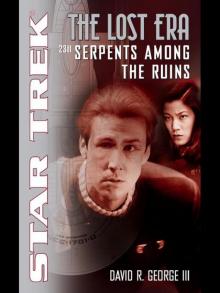 Serpents Among the Ruins
Serpents Among the Ruins The Fire and the Rose
The Fire and the Rose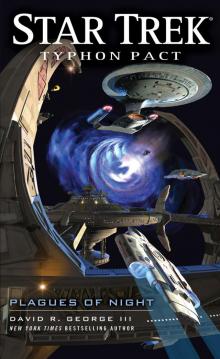 Star Trek: Typhon Pact 06: Plagues of Night
Star Trek: Typhon Pact 06: Plagues of Night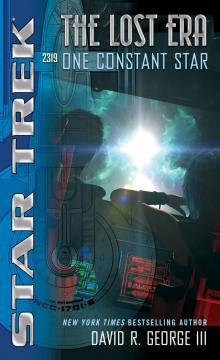 Star Trek: The Lost Era - 08 - 2319 - One Constant Star
Star Trek: The Lost Era - 08 - 2319 - One Constant Star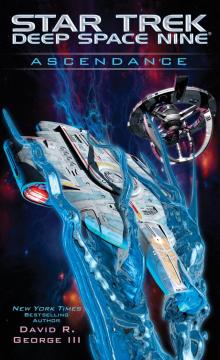 Star Trek: Deep Space Nine: Ascendance
Star Trek: Deep Space Nine: Ascendance Star Trek: TOS: Allegiance in Exile
Star Trek: TOS: Allegiance in Exile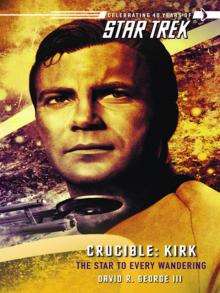 Crucible: Kirk
Crucible: Kirk Crucible: McCoy
Crucible: McCoy The Long Mirage
The Long Mirage Original Sin
Original Sin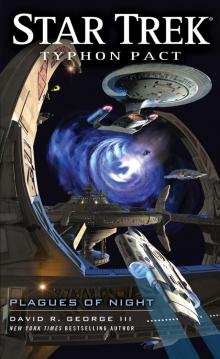 Star Trek: Typhon Pact: Plagues of Night
Star Trek: Typhon Pact: Plagues of Night Allegiance in Exile
Allegiance in Exile Sacraments of Fire
Sacraments of Fire Star Trek: Typhon Pact: Rough Beasts of Empire
Star Trek: Typhon Pact: Rough Beasts of Empire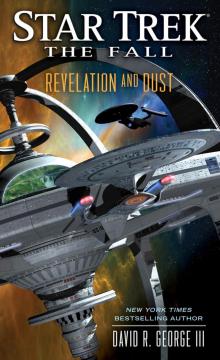 Star Trek: The Fall: Revelation and Dust
Star Trek: The Fall: Revelation and Dust